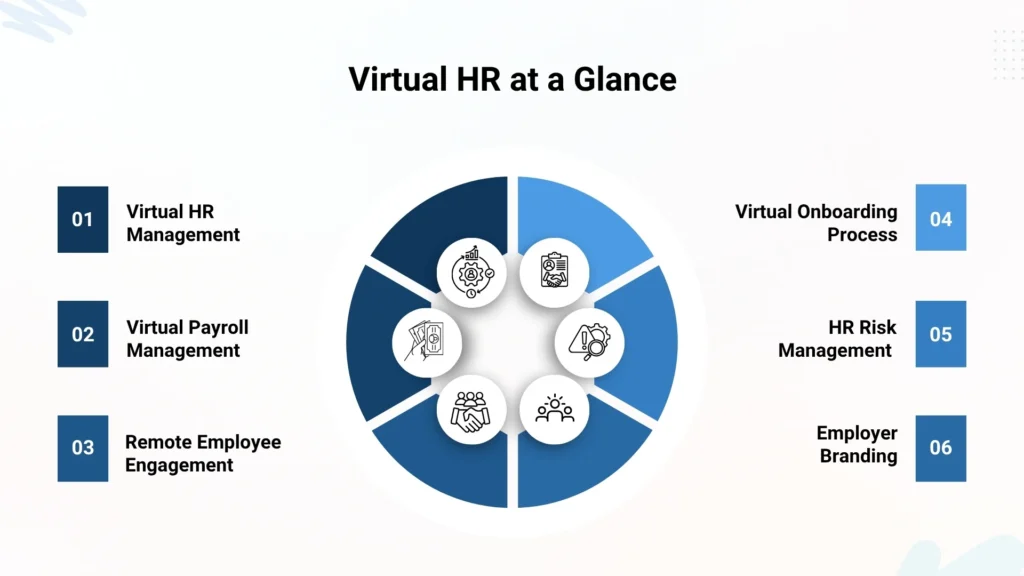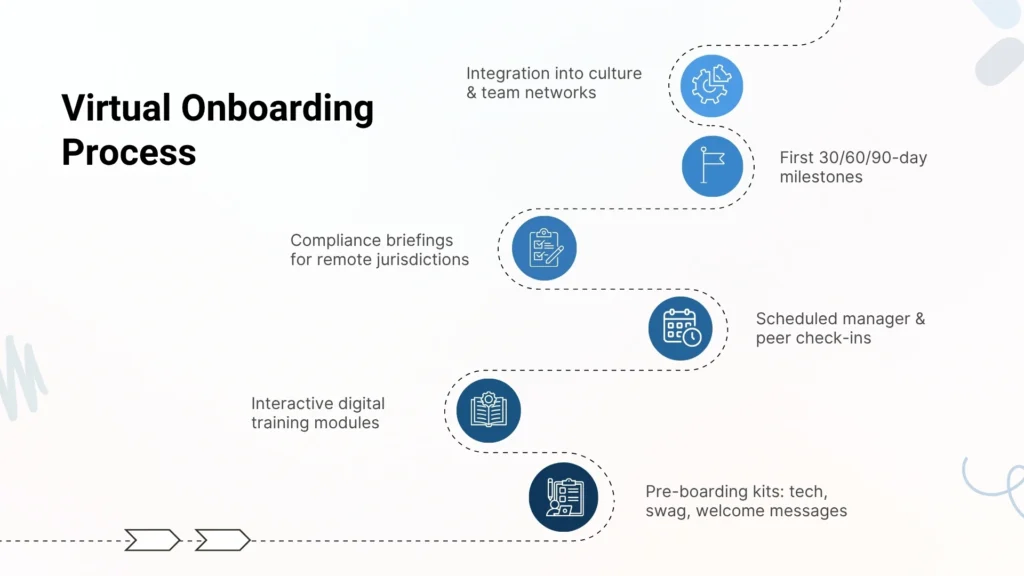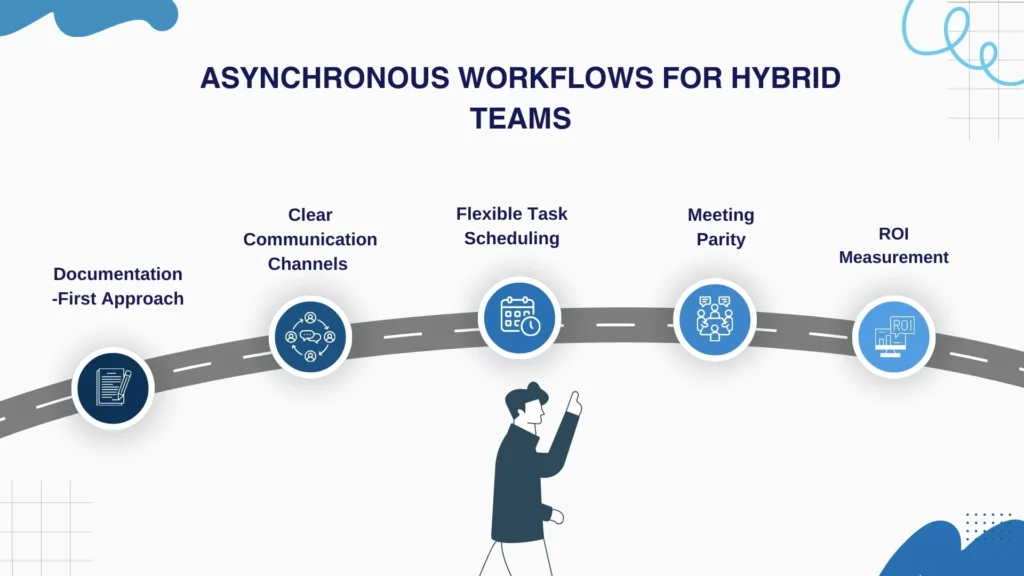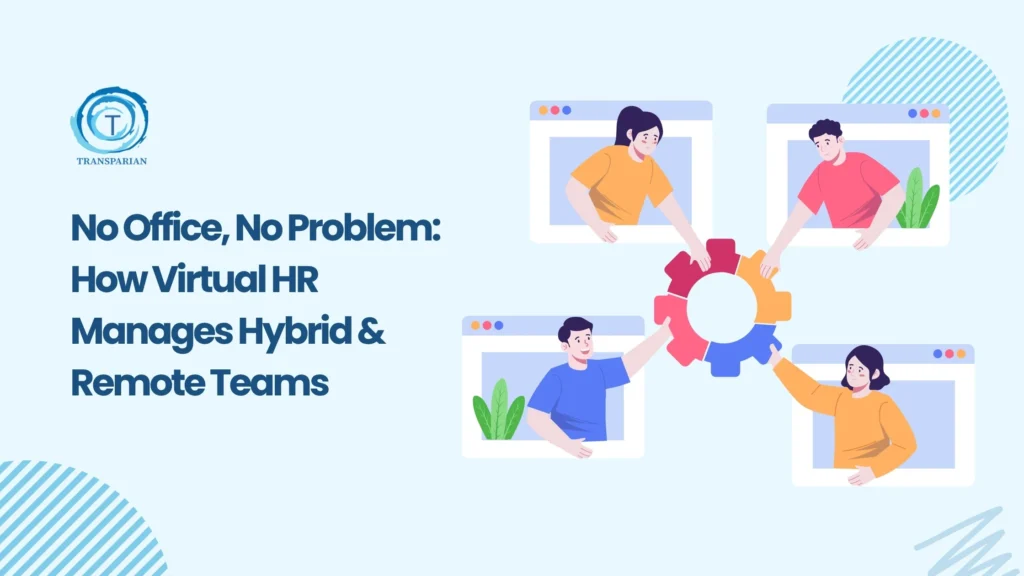The workplace has changed forever. Remote and hybrid setups are no longer stopgap solutions, they’re the default for many organizations across industries. With this shift, companies are realizing that traditional HR practices often fall short in managing a distributed workforce. Enter Virtual HR, a model that uses technology, specialized expertise, and flexible leadership to manage employees without the need for a physical HR office.
For growing businesses, startups, and even global enterprises, virtual HR management is proving to be a scalable and effective approach. It not only keeps teams connected but also ensures compliance, employee engagement, and performance remain top priorities in a world without walls.
The Rise of Virtual HR in the Hybrid Workplace
When employees are spread across different time zones and working models, the HR function must become agile. Virtual HR delivers this agility by centralizing HR functions through digital platforms while still providing the human touch employees need.
Whether it’s handling payroll, supporting remote employee engagement, or driving culture, the virtual HR model ensures that employees feel supported no matter where they log in from. This also aligns with broader goals like HR digital transformation, where organizations integrate automation, analytics, and cloud-based platforms to modernize workforce management.

Leadership Without Borders: Fractional and Outsourced CHROs
A significant advantage of virtual HR is the rise of flexible leadership models. Many businesses no longer need a full-time head of HR. Instead, they leverage Fractional CHRO solutions, giving them access to senior expertise at a fraction of the cost.
Through CHRO services, companies gain strategic guidance on workforce planning, compliance, and culture building without adding a permanent C-suite salary. This is especially valuable for startups and mid-sized firms scaling across regions. Similarly, Outsourced CHRO services provide companies with leadership on-demand, ensuring that the organization always has expert HR decision-making available when needed.
For organizations moving toward HR leadership consulting, this approach bridges the gap between tactical HR operations and strategic planning. It enables businesses to adapt policies and practices that fit both hybrid and remote models.
Payroll, Compliance & Risk in a Borderless World
One of the most overlooked aspects of remote HR is compliance. Managing labor laws, tax regulations, and workplace policies across geographies is no small feat. That’s where Virtual payroll management and HR risk management come into play.
Virtual payroll management ensures that employees are paid accurately and compliantly, regardless of location. This includes:
- Multi-country payroll processing
- Automated tax calculations
- Integration with time-tracking and leave systems
Meanwhile, HR risk management involves identifying and mitigating risks related to remote work such as data privacy breaches, misclassification of workers, and non-compliance with local employment laws. Virtual HR teams must stay updated on evolving regulations and conduct regular audits to ensure legal integrity.
The New Face of Onboarding
The virtual onboarding process is one of the most critical touchpoints in a remote employee’s journey. It sets the tone for culture, clarity, and connection. Virtual HR teams must ensure that onboarding is not just a checklist but a curated experience.
Key elements include:
- Pre-boarding kits with tech, swag, and welcome messages
- Interactive digital training modules
- Scheduled check-ins with managers and peers
- Compliance briefings tailored to remote jurisdictions

A well-executed virtual onboarding process boosts retention, accelerates productivity, and strengthens employer branding. It signals to new hires that the company is invested in their success even from afar.
Driving Remote Employee Engagement Beyond Team Calls
Weekly video meetings are not enough to keep employees engaged. Remote employee engagement requires creativity and strategy. Virtual HR leaders use recognition platforms, digital wellness programs, and flexible benefits to strengthen motivation.
Engagement also extends to career growth. Virtual HR leaders ensure that hybrid employees have access to learning platforms, mentorship, and promotion opportunities. Without deliberate strategies, remote employees can be overlooked in succession planning. Incorporating engagement into the broader scope of performance management ensures fairness and transparency in how employees are evaluated and rewarded.
HR Risk Management in a Distributed World
A remote-first setup isn’t without risks. From compliance missteps to cybersecurity threats, HR must actively manage vulnerabilities. HR risk management ensures policies are clear, contracts are compliant, and sensitive employee data is protected.
Remote work also raises the risk of misclassification treating employees as contractors or vice versa. Virtual HR frameworks include compliance checks and legal reviews to minimize exposure. At the same time, risk management extends to employee relations ensuring that issues like harassment or bias in hybrid teams are handled with transparency and fairness.
Employer Branding in the Age of Flexibility
Today’s talent wants more than a paycheck, they want purpose, flexibility, and belonging. That’s why employer branding is a top priority for Virtual HR. It’s about positioning the company as a great place to work, regardless of location.
Strategies include:
- Showcasing remote work success stories
- Highlighting DEI initiatives
- Promoting flexible work policies
- Creating digital content that reflects company culture
A strong employer brand attracts top talent, reduces hiring costs, and boosts retention. It also differentiates the company in a crowded market where remote roles are the norm.
Beyond the Basics: The Missed Elements of Virtual HR
While many organizations focus on communication and tools, there are deeper layers that drive the success of virtual HR management:

- Asynchronous workflows: Shifting from meeting-heavy cultures to documentation-first systems that allow employees to work productively across time zones.
- Training remote managers: Virtual HR equips leaders with skills to manage performance, foster inclusion, and build trust without in-person interactions.
- Security and compliance: Remote work requires structured SOPs for device policies, data access, and secure file sharing.
- Measuring ROI of HR: Companies increasingly need to track the return on virtual HR through metrics like retention, engagement scores, and cost savings.
- Hybrid meeting parity: Designing office setups and AV systems that ensure in-office and remote employees participate equally.
These areas are crucial for companies looking not just to maintain, but to thrive with hybrid and remote setups.
Virtual HR as the Foundation for the Future of Work
The future of HR isn’t about managing offices, it’s about managing people, regardless of where they work. With the right combination of CHRO services, HR leadership consulting, and Outsourced CHRO services, organizations can maintain strategic HR leadership without overextending budgets.
By adopting Virtual HR, investing in virtual payroll management, creating a seamless virtual onboarding process, and focusing on remote employee engagement, companies set themselves up for long-term success. The shift is not just about convenience, it’s about building resilient systems that can support employees in any work environment.
Hybrid and remote work are here to stay, and with strong practices in performance management, proactive HR risk management, and forward-looking HR digital transformation, organizations can ensure their teams thrive without ever needing to step into a traditional office.
FAQ’s
Virtual HR is the management of HR functions remotely using technology, digital platforms, and expert guidance, enabling organizations to handle onboarding, payroll, engagement, and performance without a physical office.
A structured virtual onboarding process ensures new hires are integrated quickly, understand company culture, and become productive faster, while keeping engagement high for distributed teams.
Through tools, recognition programs, mentorship, and clear communication, Virtual HR fosters a sense of belonging and motivation, ensuring that remote employees remain connected and engaged.
HR leadership consulting helps organizations design policies, manage culture, implement performance management frameworks, and address remote work challenges effectively.
HR digital transformation integrates cloud platforms, automation, and analytics to streamline virtual HR management, onboarding, payroll, engagement, and compliance for distributed workforces.
Risks include payroll errors, misclassification of employees, data security breaches, and reduced engagement. HR risk management strategies mitigate these challenges.

